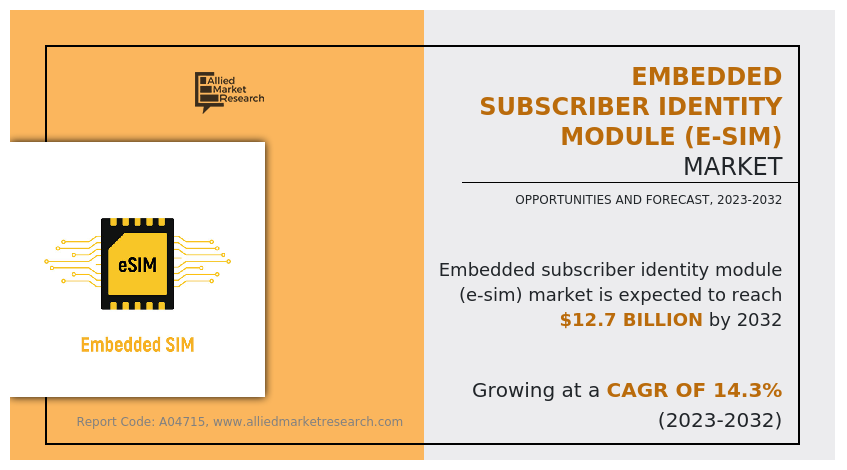An eSIM is a type of SIM card that is embedded directly into a device during the manufacturing process. It is a small chip or module that serves the same purpose as a traditional SIM card: to identify and authenticate the device on a mobile network.
According to a new report published by Allied Market Research, titled, “eSIM Market by Application (Connected Car, Smartphone and Tablet, Wearable Device, Others), by Industry Vertical (Automotive, Consumer Electronics, Manufacturing, Telecommunication, Transportation and Logistics, Others): Global Opportunity Analysis and Industry Forecast, 2023-2032,” the eSIM market size was valued at $3.4 billion in 2022, and is estimated to reach $12.7 billion by 2032, growing at a CAGR of 14.3% from 2023 to 2032.
Enhanced security is a significant driver behind the growth of the eSIM market share. E-SIMs offer robust security measures to protect user data and ensure secure communication. One of the key security features of E-SIM technology is the incorporation of tamper-resistant hardware and encryption mechanisms. These security measures make it extremely difficult for unauthorized access or tampering with the E-SIM. As a result, industries that handle sensitive information, such as healthcare, finance, and government, have increasingly adopted E-SIM technology to ensure secure connectivity. Thus, driving the eSIM Market Growth.
The eSIM market key players profiled in the report include STMicroelectronics, Infineon Technologies AG, Thales, Sierra Wireless, Deutsche Telekom AG, Giesecke+Devrient Mobile Security GmbH, Telenor group, Vodafone Group Plc, NTT DOCOMO, Inc., and NXP semiconductors. The market players have adopted various strategies, such as agreements, mergers, partnerships, product launches, collaborations, and new product developments to expand their foothold in the eSIM industry.
Download Report Sample:
https://www.alliedmarketresearch.com/request-sample/5077
However, the complex implementation of E-SIM technology poses a restraint, particularly for smaller device manufacturers. Integrating E-SIM into devices and ensuring compatibility with different networks requires substantial investments in research, development, and testing. This process may be time-consuming and expensive, creating a barrier for manufacturers with limited resources.
On the other hand, embedded-SIM technology offers significant opportunities for telecommunications companies to enhance their service offerings. Mobile network operators (MNOs) may provide customers with flexible plans that allow them to switch providers easily with a digital SIM card, with E-SIM. This means that customers may change their service provider or subscription plan seamlessly, directly from their device settings. In addition, E-SIM enables remote provisioning and management of E-SIM profiles, eliminating the need for physical distribution and activation of SIM cards. This reduces logistics costs and streamlines the onboarding process for customers.
The eSIM market analysis is segmented on the basis of application, industry vertical, and region. On the basis of application, the market is divided into connected cars, smartphones & tablets, wearable devices, and others. On the basis of industry vertical, the market is segregated into automotive, consumer electronics, manufacturing, telecommunication, transportation & logistics, and others.
On the basis of region, the eSIM Market Trends are analyzed across North America (the U.S., Canada, and Mexico), Europe (the UK, Germany, France, Italy, and Rest of Europe), Asia-Pacific (China, Japan, India, South Korea, and Rest of Asia-Pacific) and LAMEA (Latin America, Middle East, and Africa).
Want to Access the Statistical Data and Graphs, Key Players’ Strategies: https://www.alliedmarketresearch.com/purchase-enquiry/5077
Key Findings of the Study
-
In 2022, by application, connected car segment was the highest revenue contributor to the market, with $1,196.9 million in 2022, and is estimated to reach $5,054.47 million by 2032, with a CAGR of 15.58%.
-
By industry vertical, the automotive segment was the highest revenue contributor to the market, with $839.59 million in 2022, and is estimated to reach $3,453.94 million by 2032, with a CAGR of 15.28%.
-
By region, North America was the highest revenue contributor, accounting for $1,084.01 million in 2022, and is estimated to reach $4,501.46 million by 2032, with a CAGR of 15.39%.

